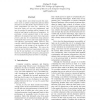Free Online Productivity Tools
i2Speak
i2Symbol
i2OCR
iTex2Img
iWeb2Print
iWeb2Shot
i2Type
iPdf2Split
iPdf2Merge
i2Bopomofo
i2Arabic
i2Style
i2Image
i2PDF
iLatex2Rtf
Sci2ools
ISMVL
2005
IEEE
2005
IEEE
Approaching the Physical Limits of Computing
As logic device sizes shrink towards the nanometer scale, a number of important physical limits threaten to soon halt further improvements in computer performance per unit cost. However, the near-term limits are not truly fundamental, and may be avoided by making radical changes to the physical and logical architecture of computers. In particular, certain assumed limits to the energy efficiency of computers have never been rigorously proven, and may be circumvented using physical mechanisms that recover and reuse signal energies with efficiency approaching 100%. However, this concept, called reversible computing, imposes tight constraints on the design of the machine at all levels from physics to algorithms. We review the physical and architectural requirements that must be met if real machines are to break through the barriers preventing further progress, and approach the true fundamental physical limits to computing.
Artificial Intelligence | Certain Assumed Limits | Important Physical Limits | ISMVL 2005 | Physical Limits |
Related Content
| Added | 25 Jun 2010 |
| Updated | 25 Jun 2010 |
| Type | Conference |
| Year | 2005 |
| Where | ISMVL |
| Authors | Michael P. Frank |
Comments (0)

